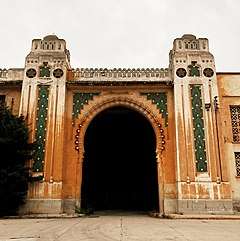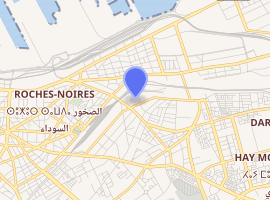Old Abattoirs
The Former Abattoirs or the Former Slaughterhouses of Casablanca (Arabic: مسالخ الدار البيضاء القديمة, French: Anciens Abattoirs de Casablanca)[1] were constructed under the French protectorate in Morocco in 1912 in the neighborhood of Hay Mohammadi in Casablanca.[2][3]
| Former Abattoirs | |
|---|---|
المسالخ القديمة Anciens Abattoirs | |
 | |

| |
| General information | |
| Town or city | Casablanca |
| Country | Morocco |
| Coordinates | 33.5948°N 7.5819°W |
| Groundbreaking | 1912 |
| Renovated | 1922 |
| Design and construction | |
| Architect | George-Ernest Desmarest, renovated by Henri Prost |
History
The one-time slaughterhouses of Casablanca were constructed by architect George-Ernest Desmarest in 1912 and modernized in 1922 by Henri Prost.
They were expanded in 1951, then closed in 2002, substituted by new slaughterhouses in the periphery of Casablanca.
Abandoned since 2002, the approximately 14 acre complex became host to a public art movement, with free performances, workshops, and concerts.[4] Theatre Nomade is still based there.[4]
Architecture
The Former Abattoirs were built in a style inspired by Neo-Mauresque, or Moorish Revival, as well as Art Deco.[5]
References
- "هجرة سريّة إلى "بولفار" المغرب". الأخبار (in Arabic). Retrieved 2019-10-04.
- ""باطوار البيضاء": مرفق بـ80 ملياراً يسدّ أقل من ثُلث الحاجيات." Hespress (in Arabic). Retrieved 2019-10-04.
- The Casablanca Abattoir's culture factory : story of a transformation = Fabrique culturelle des Abattoirs de Casablanca : histoire d'une reconversion. Daïf, Maria. [Casablanca]: Casamémoire. DL 2013, cop. 2013. ISBN 9789954329559. OCLC 896988730. Check date values in:
|date=(help)CS1 maint: others (link) - Terhune, Erika Riley, Ryan. "Why Is One of Casablanca's Thriving Artists' Spaces Now Empty?". CityLab. Retrieved 2019-10-04.
- "Mutual Heritage". Mutual Heritage.
Further reading
L'Batwar - Fabrique culturelle des Abattoirs de Casablanca - Histoire d'une reconversion. Jean-Louis Cohen, Najib Taki, Driss Ksikes. Sirocco. 2014. 978-9954-32-955-9.